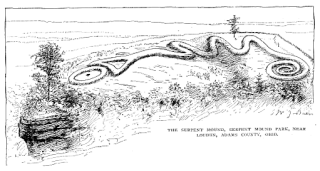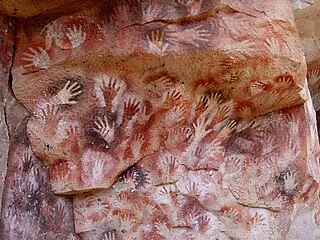Related Research Articles

The archaeology of the Americas is the study of the archaeology of the Western Hemisphere, including North America (Mesoamerica), Central America, South America and the Caribbean. This includes the study of pre-historic/pre-Columbian and historic indigenous American peoples, as well as historical archaeology of more recent eras, including the trans-Atlantic slave trade and European colonization.
Below are notable events in archaeology that occurred in 1913.

Stuart Ernest Piggott, was a British archaeologist, best known for his work on prehistoric Wessex.

In the sequence of cultural stages first proposed for the archaeology of the Americas by Gordon Willey and Philip Phillips in 1958, the Lithic stage was the earliest period of human occupation in the Americas, as post-glacial hunter gatherers spread through the Americas. The stage derived its name from the first appearance of Lithic flaked stone tools. The term Paleo-Indian is an alternative, generally indicating much the same period.
Below are notable events in archaeology that occurred in 1918.
The year 1964 in archaeology involved some significant events.

Cueva de las Manos is a cave and complex of rock art sites in the province of Santa Cruz, Argentina, 163 km (101 mi) south of the town of Perito Moreno. It is named for the hundreds of paintings of hands stenciled, in multiple collages, on the rock walls. The art was created in several waves between 7,300 BC and 700 AD, during the Archaic period of pre-Columbian South America. The age of the paintings was calculated from the remains of bone pipes used for spraying the paint on the wall of the cave to create the artwork, radiocarbon dating of the artwork, and stratigraphic dating.
Gordon Randolph Willey was an American archaeologist who was described by colleagues as the "dean" of New World archaeology. Willey performed fieldwork at excavations in South America, Central America and the Southeastern United States; and pioneered the development and methodology for settlement patterns theories. He worked as an anthropologist for the Smithsonian Institution and as a professor at Harvard University.
Below are notable events in archaeology that occurred in 1945.

The Fort Walton Mound (8OK6) is an archaeological site located in present-day Fort Walton Beach, Florida, United States. The large platform mound was built about 850 CE by the Pensacola culture, a local form of the Mississippian culture. Because of its significance, the mound was designated a National Historic Landmark in 1964.
The decade of the 1740s in archaeology involved some significant events.

The Metropolitan Cathedral of Saint Paul, commonly known as St Paul's Cathedral or the Mdina Cathedral, is a Catholic cathedral in Mdina, Malta, dedicated to St. Paul the Apostle. The cathedral was founded in the 12th century, and according to tradition it stands on the site where Roman governor Publius met St. Paul following his shipwreck on Malta. The original cathedral was severely damaged in the 1693 Sicily earthquake, so it was dismantled and rebuilt in the Baroque style to a design of the Maltese architect Lorenzo Gafà between 1696 and 1705. The cathedral is regarded as Gafà's masterpiece.
Augustus Ledyard Smith III was an American archaeologist who worked on various projects in the Maya region on behalf of the Carnegie Institution, including Uaxactun. From 1958 to 1963 he led investigations at Altar de Sacrificios in Guatemala together with Gordon Willey on behalf of the Peabody Museum of Archaeology and Ethnology. From 1963 to 1969 he investigated the site of Seibal, also in Guatemala.

The Domus Romana, stylized as the Domvs Romana, is a ruined Roman-era house located on the boundary between Mdina and Rabat, Malta. It was built in the 1st century BC as an aristocratic town house (domus) within the Roman city of Melite. In the 11th century, a Muslim cemetery was established on the remains of the domus.
This page lists major archaeological events of 2016.

Melite or Melita (Latin) was an ancient city located on the site of present-day Mdina and Rabat, Malta. It started out as a Bronze Age settlement, which developed into a city called Ann under the Phoenicians and became the administrative centre of the island. The city fell to the Roman Republic in 218 BC, and it remained part of the Roman and later the Byzantine Empire until 870 AD, when it was captured and destroyed by the Aghlabids. The city was then rebuilt and renamed Medina, giving rise to the present name Mdina. It remained Malta's capital city until 1530.
The Temple of Apollo was a Roman temple in the city of Melite, in modern Mdina, Malta. It was dedicated to Apollo, the god of the sun and music. The temple was built in the 2nd century AD, and it overlooked a semi-circular theatre. The temple's ruins were discovered in the 18th century, and many architectural fragments were dispersed among private collections or reworked into new sculptures. Parts of the temple's crepidoma still exist, having been rediscovered in 2002.
This page lists major events of 2019 in archaeology.

Carlos Joaquín Gradin, also known as Carlos Gradín, was an Argentine surveyor and archaeologist. He carried out numerous studies in the Patagonian region, and is known for his extensive studies of Cueva de las Manos. He was a member of the National Scientific and Technical Research Council (CONICET).

The Mdina Cathedral Museum is a religious art museum located inside the mediaeval walled city of Mdina, Malta. The museum is housed within a Baroque building that was built as a Jesuit seminary. It can be found on the right-hand side of the St. Paul's Cathedral, in Archbishop's Square. The museum's collection includes an eclectic secular and ecclesiastical repertoire. The museum also holds various artwork and archaeology remains, including important artwork by Mattia Preti. The museum also owns the most important collection of Italian Baroque music that has been preserved south of Naples.
References
- ↑ Testa, Michael (19 March 2002). "New find at Mdina most important so far in old capital". Times of Malta . Archived from the original on 13 April 2016.
- ↑ "最古級の漆製品焼失で視察/関係者が北海道南茅部町に" [Officials in Minamikayabe, Hokkaido say oldest lacquerware was burned]. Shikoku News (in Japanese). 2002-12-30. Retrieved 2020-11-01.
- ↑ "Lands, Hands And Cyanide: Mining Expansion In Northwest Santa Cruz". www.minesandcommunities.org. Retrieved 2021-04-21.
- ↑ "Cueva de las Manos. Historia de las Investigaciones en el sitio arquelógico". www.cuevadelasmanos.org. Retrieved 2021-05-01.
- ↑ Identifiants et référentiels pour l'Enseignement. "Gradín, Carlos Joaquín (1918-2002)" (in French). Archived from the original on 2021-05-01. Retrieved 2021-05-23.
- ↑ Gradin, Carlos J.; Oliva, Fernando (2004). La región pampeana: su pasado arqueológico. Laborde. ISBN 987-9459-68-7. OCLC 1025944494. In The Library of Congress. "Gradin, Carlos J." id.loc.gov. LCCN no92033009. Archived from the original on 2021-05-02. Retrieved 2021-06-22.
- ↑ "Obituary: Gordon Willey". theguardian.com. 10 May 2002. Retrieved 15 March 2017.
- ↑ "Obituary: Barbara Adams". The Guardian. 13 July 2002. Retrieved 9 October 2017.